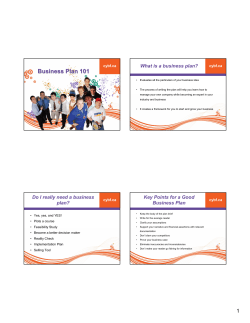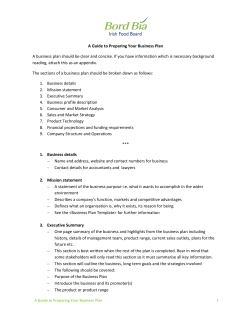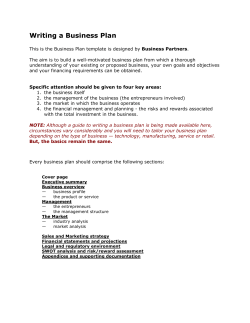
W Business Planning for Success BUSINESS BEGINNINGS
Embassy of the United States of America BUSINESS BEGINNINGS Business Planning for Success W hether you are just starting out or ready to expand your enterprise, a business plan is your blueprint for success. Projecting three to five years into the future, a business plan articulates your business goals and clarifies your path to achieving those goals. A business plan is essential to attracting investment for startups. It is also an important tool for managing and expanding an established business. Because each business is different, each business plan is different. But every business plan should contain the following elements: Executive Summary The Executive Summary section offers a snapshot of your business plan. It touches on your business’s mission, history, organization and structure. The executive summary should provide a brief Writing a business plan helps you solidify business goals and develop measurements of success. © iStockphoto/Thinkstock overview of your products or services, your strategy for marketing your products or services, and a summary of projected sales, profits and cash flows. how you will handle accounting, insurance, legal and security matters. If you are using your business plan to attract investment, the executive summary should also state how much capital you need and how you intend to use it. The Market Analysis section describes your industry, the market for your products or services and the competition your business faces. Whether you hire a market-research company or use the Internet, your market analysis should be based on real data and demonstrate how your business will be successful. Your market analysis describes your industry’s current size, historic growth and trends; pinpoints your target market, its distinguishing characteristics and needs; and identifies your competition, its strengths and its weaknesses. Because the executive summary encapsulates the entire business plan, it will be the last section you write — and the first section of your business plan. Business Description The Business Description section explains what your business does. It includes your business’s history, mission, organizational structure and strategy for marketing. It should also cover administrative issues such as business location, legal structure and personnel, and explain Market Analysis Organization and Management Marketing and Sales Strategy The Organization and Management section captures the organizational structure of your business and the background of its key people. It discusses your business’s divisions, their respective responsibilities and how they interact. Including organizational charts can be a good way to convey this information visually. You should also include the experience and responsibilities of your business’s executives. Show how each will help your business achieve its goals. Your Marketing and Sales Strategy section details how you will market and sell your product or service. The marketing strategy includes how you will identify and attract customers; how you will grow your business; how you will distribute your product or service; and how you will communicate with your target market. The sales strategy outlines how you intend to sell your product. Product or Service In the Product or Service section, you should highlight the product(s) or service(s) your business provides and what makes it superior to the competition. Show how your product or service will satisfy a need in your target market and help your business maintain a competitive advantage. You should also include the scheduling, costs and personnel needed to deliver your product or service, along with any potential risks and how you will mitigate those risks. The U.S. Small Business Administration sponsors a website that offers ideas for business plans and other helpful information at business.usa.gov. Published January 2013 Funding Request (Optional) If you are using your business plan to attract investors, this section should state the capital your business requires and how your business will use that capital. Financial Projections The Financial Projections section forecasts the future financial health of your business. It should include three documents: an income statement projecting how much your company will earn or lose; a cash-flow statement illustrating how much cash your business will need and where that cash will come from; and a balance sheet reflecting how much your business will own versus how much it will owe. A good business plan provides monthly projections for the first year, quarterly projections for the second year, and annual projections for your plan’s remaining years. You should complete this section after your organizational and marketing sections. Established businesses should also provide historical financial data. Income statements, cash-flow statements and balance sheets for the previous five years should suffice. Include graphs and charts to illustrate visually the content of your business plan. © iStockphoto/Thinkstock Appendix Thie appendix provides supplemental materials such as resumes of your company’s leaders, product designs, complete market analysis, legal documents and reference letters. The appendix should be distributed on an as-needed basis — especially if it contains sensitive information. Updates Once you have completed your business plan, review it regularly to monitor the progress of your business and make necessary adjustments. Keep a record of every business plan you distribute. This allows you to update all copies of your business plan — and ensures your information stays in the right hands. If you plan to give your business plan to private investors, include a private placement disclaimer. This disclaimer prohibits the investor from distributing your information and should be placed at the beginning of your business plan. U N I T E D S TAT E S D E PA RT M E N T O F S TAT E B U R E A U O F I N T E R N AT I O N A L I N F O R M AT I O N P R O G R A M S
© Copyright 2025





![-- FREE VERSION -- BUSINESS PLAN [Company Logo]](http://cdn1.abcdocz.com/store/data/000167608_1-42df28f9b0d5f3010b555b6dd3118db4-250x500.png)















